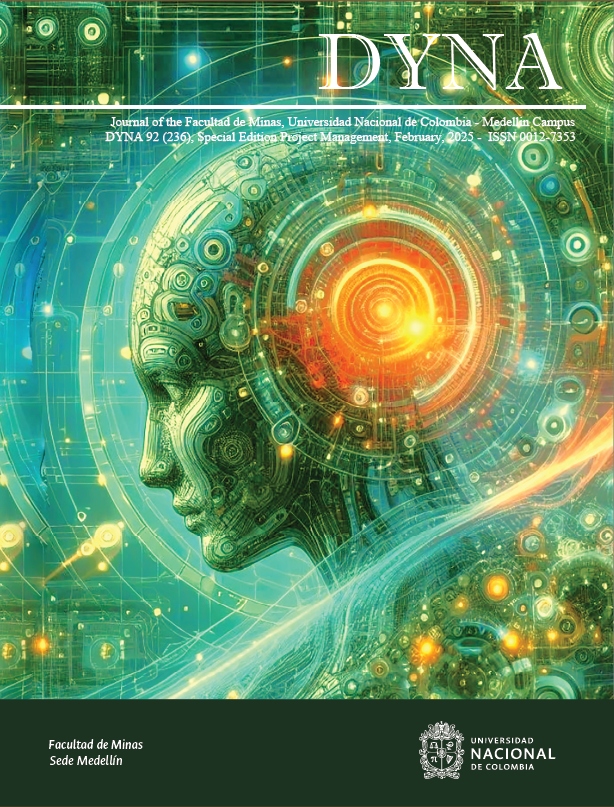Analyzing emotion in Project Management
Analizando las emociones en la Gestión de Proyectos
DOI:
https://doi.org/10.15446/dyna.v92n236.116997Palabras clave:
project management, emotions, positive, negative, communication, engagement (en)gestión de proyectos, emociones, positivas, negativas, comunicación, compromiso (es)
Descargas
This article analyzes different ways emotions have been studied and applied to promote better communication and working conditions, leading to more successful projects and helping build stronger relationships between members. Project management relies on emotions because it depends on human communication and interactions, which can help reduce or escalate conflict. Emotional closeness is essential in interpersonal interactions and relationships. It is also essential to motivate members. Special attention is given to communication inside project teams since it is essential in building trust and developing strong relationships. When emotions are handled adequately, trust and strong bonds develop. In project management, members are bound together by a sense of common identity, sharing professional values and interests. The stronger the connections between members, the higher the productivity and support. Specific ways to connect in project management emerge due to the very nature of projects and the closeness of the members.
Este artículo analiza las diferentes formas en que se han estudiado y aplicado las emociones para promover una mejor comunicación y condiciones de trabajo, lo que conduce a proyectos más exitosos y ayuda a construir relaciones más sólidas entre los miembros. La gestión de proyectos se basa en las emociones porque depende de la comunicación e interacciones humanas, lo que puede contribuir a reducir o aumentar los conflictos. La cercanía emocional es un aspecto importante de las interacciones interpersonales y las relaciones. También es esencial para motivar a los miembros. Se presta especial atención a la comunicación dentro de los equipos, ya que es esencial para construir confianza y desarrollar relaciones sólidas. Cuando las emociones se manejan adecuadamente, se desarrolla la confianza y también se fortalecen los vínculos. En la gestión de proyectos, los miembros están unidos por un sentido de identidad común, compartiendo valores e intereses profesionales. Cuanto más fuertes sean las conexiones entre los miembros, mayor será la productividad y el apoyo. En la gestión de proyectos, surgen formas específicas de conexión debido a la naturaleza misma de los proyectos y la cercanía de los miembros.
Referencias
[1] Ullah, N., Rakesh, R., Shariar, F., Ahmed, S., Sakib, K., and Chowdhury, T., Effects of triple constraints on project success: Evidence from Bangladesh, 2023.
[2] Bass, B.M., and Norton, F.T.M., Group size and leaderless discussions, Journal of Applied Psychology, 35(6), art. 397, 1951. DOI: https://doi.org/10.1037/h0055478
[3] Doan, T.T.T., Nguyen, L.C.T., and Nguyen, T.D.N., Emotional intelligence and project success: the roles of transformational leadership and organizational commitment. The Journal of Asian Finance, Economics and Business, 7(3), pp. 223-233, 2020. DOI: https://doi.org/10.13106/jafeb.2020.vol7.no3.223
[4] Pavez, I., Gómez, H., Laulié, L., and González, V.A., Project team resilience: the effect of group potency and interpersonal trust. International Journal of Project Management, 39(6), pp. 697-708, 2021. DOI: https://doi.org/10.1016/j.ijproman.2021.06.004
[5] Eskerod, P., and Hollensen, S., Hero’s journey as a framework to study a project manager, International Journal of Managing Projects in Business, 17(6-7), pp. 880-897, 2024. DOI: https://doi.org/10.1108/IJMPB-04-2024-0085
[6] Rehan, A., Thorpe, D., and Heravi, A., Project success factors for leadership practice and communication: challenges in the construction sector, International Journal of Managing Projects in Business, 17(3), pp. 562-590, 2024. DOI: https://doi.org/10.1108/IJMPB-12-2023-0279
[7] Moradi, S., Kähkönen, K., and Aaltonen, K., Project managers’ competencies in collaborative construction projects. Buildings, 10(3), 50, 2020. DOI: https://doi.org/10.3390/buildings10030050
[8] Nawi, M.N.M., Omar, M.F., Odeh, R.A., Hanafi, A.G., Nifa, F.A.A., and Rahim, M.K.I.A., A conceptual approach of an integrated multi criteria decision making techniques and deep learning for construction project managers selection problem. International Journal of Interactive Mobile Technologies, 18(13), pp. 166-178, 2024. DOI: https://doi.org/10.3991/ijim.v18i13.49119
[9] Khosravi, P., Rezvani, A., and Ashkanasy, N.M., Emotional intelligence: a preventive strategy to manage the destructive influence of conflict in large scale projects. International Journal of Project Management, 38(1), pp. 36-46, 2020. DOI: https://doi.org/10.1016/j.ijproman.2019.11.001
[10] Yamada, N.K., Business ethics and inter-religious contribution in the age of globalization, in Bettignies, H.C., and Lépineux, F., (eds), Business, Globalization, and the Common Good, Bern: Peter Lang AG, International Academic Publishers, 2009, pp. 121-135.
[11] Flores, Jr, L.E., and Berenbaum, H., Desire for emotional closeness moderates the effectiveness of the social regulation of emotion, Personality and Individual Differences, 53(8), pp. 952-957, 2012. DOI: https://doi.org/10.1016/j.paid.2012.07.009
[12] Seham, A.E., Whose improv is it anyway?: beyond second city, University Press of Mississippi, 2001.
[13] Hart, Y., et al. Individuality and togetherness in joint improvised motion, PloS one, 9(2), art. e87213, 2014. DOI: https://doi.org./10.1371/journal.pone.0087213.
[14] Bauman, Z., Making and Unmaking of Strangers, Thesis Eleven, 43(1), pp. 1-16, 1995. DOI: https://doi.org/10.1177/0725513695043001
[15] Lenhardt, V., and Bernard, P., L'intelligence collective en action: repères pour une co-construction du sens de l'entreprise, Pearson, 2021.
[16] Peck, M.S., Introduction: The Frontier of Group Space, in: Community Building: Renewing Spirit & Learning in Business, 1995, pp. 1-6. DOI: https://doi.org/10.1017/CBO9780511558344.001
[17] Crittenden, J., Beyond individualism: reconstituting the liberal self, Oxford University Press, 1992. DOI: https://doi.org/10.1093/oso/9780195073300.001.0001
[18] Zemke, R. The call of community: blame it on aging Baby Boomers or nostalgia for the good old days, but there's a movement afoot to create a sense of community at work, Training, 33, pp. 24-31, 1996.
[19] Chavanne, P.M., and Truong, O., La bienveillance en entreprise: utopie ou réalité?, Editions Eyrolles, 2017.
[20] Goleman, D., Social intelligence, Random House, 2007.
[21] Lee Sinden, J., and Devall-Martin, L., Emotions are not in the way, they are the way: abolishing unhealthy beliefs about emotion and cultivating the spiritual–emotional development of athletes, Religions, 15(3), pp. 270, 2024. DOI: https://doi.org/10.3390/rel15030270
[22] Weiss, H.M., and Cropanzano, R., Affective events theory, Research in Organizational Behavior, 18(2), pp. 1-74, 1996.
[23] Bakker, A.B., and Demerouti, E., Towards a model of work engagement, Career Development International, 13(3), pp. 209-223, 2008. DOI: https://doi.org/10.1108/13620430810870476
[24] Shaw, N., Showing emotions at work could boost productivity, research says, The Chronicle Live. [Online]. [Accessed: May 10th, 2024]. Available at: https://www.chroniclelive.co.uk/business/business-news/showing-emotions-work-could-boost-24681397.
[25] Hällgren, M., Rouleau, L., and De Rond, M., A matter of life or death: How extreme context research matters for management and organization studies, Academy of Management Annals, 12(1), pp. 111-153, 2018. DOI: https://doi.org/10.5465/annals.2016.0017
[26] Aniello, F.D., Emotions at work within organizations, Bulletin of the Transilvania University of Braşov, Series VII: Social Sciences and Law, 2, pp. 9-16, 2015.
[27] Alexander, J.M., and Buckingham, J., Common good leadership in business management: an ethical model from the Indian tradition, Business Ethics: A European Review, 20(4), pp. 317-327, 2011. DOI: https://doi.org/10.1111/j.1467-8608.2011.01632.x
[28] Migeon, D., Bienveillance, éthique et empathie en entreprise. Maxima Eds., Paris, France, 2018.
[29] Nichols, R.G., and Stevens, L.A., Listening to people, Reporter, [Online]. 8, pp. 4-8, 1978. Available at: https://heinonline.org/HOL/LandingPage?handle=hein.journals/report4&div=6&id=&page=
[30] Flynn, J., Välikoski, T., and Grau, J., Listening in the business context: reviewing the state of research, International Journal of Listening, 22, pp. 141-151, 2008. DOI: https://doi.org/10.1080/10904010802174800
[31] Zigarmi, D., Nimon, K., Houson, D., Witt, D., and Diehl, J., Beyond engagement: toward a framework and operational definition for employee work passion, Human Resource Development Review, 8(3), pp. 300-326, 2009. DOI: https://doi.org/10.1177/1534484309338171
[32] Mann, P., Permanence and evolution of the repertoire of collective action of French farmers since 1970, Economie Rurale (France), 1991.
[33] Neal, J., Spirituality: the secret in project management. Industrial Management, [online]. 55(4), 2013. Available at: https://www.iise.org/details.aspx?id=36242
[34] Buttrick, G.A., So, we believe, so we pray. Read Books, New York, USA, 2013.
[35] Hatch, M.J., and Schultz, M., Organizational identity: a reader. Oxford University Press, Oxford, 2004.
[36] Taleb, N.N., Skin in the game. Hidden asymmetries in daily life. Random House, New York, USA, 2018.
[37] Goffee, R., and Jones, G., What holds the modern company together? Harvard Business Review, 74(6), pp. 133-148, 1996.
[38] Blumer, H., Social problems as collective behavior, Social Problems, 18(3), pp. 298-306, 1971. DOI: https://doi.org/10.1525/sp.1971.18.3.03a00020
[39] Maritain, J., Integral humanism, freedom in the modern world, and a letter on independence, 1996.
[40] Salvatore, A., The reform project in the emerging public spheres, in Islam and modernity: key issues and debates, 2009, pp. 185-188. DOI: https://doi.org/10.1515/9780748637942-008
[41] Wilkinson, R., and Pickett, K., Why greater equality makes societies stronger: the spirit level. Bloomsbury Press, New York, USA, 2010.
[42] Mishra, P., Dangayach, G.S., and Mittal, M.L., An ethical approach towards sustainable project success. Procedia-Social and Behavioral Sciences, 25, pp. 338-344, 2011. DOI: https://doi.org/10.1016/j.sbspro.2011.10.552
[43] Mintzberg, H., and Azevedo, G., Fostering 'Why not?' social initiatives–beyond business and governments, Development in Practice, 22(7), pp. 895-908, 2012. DOI: https://doi.org/10.1080/09614524.2012.696585
[44] Valickas, A., Raišienė, A.G., and Arimavičiūtė, M., Leadership competences for the excellence of municipalities’ strategic management, Journal of International Studies, 10(4), pp. 131-142, 2017. DOI: https://doi.org/10.14254/2071-8330.2017/10-4/10
[45] Festinger, L., and Aronson, E., The arousal and reduction of dissonance in social contexts, Group Dynamics, pp. 214-231, 1960.
[46] Laski, H.J., Grammar of politics. Anamika Pub & Distributors, 2005.
[47] Farasi, S.N., and Anshori, M.I., Teamship Competence. Nomico, 1(4), pp. 131-139, 2024. DOI: https://doi.org/10.62872/5gmmw812
[48] Edmondson, A.C., Teaming: How organizations learn, innovate, and compete in the knowledge economy. John Wiley & Sons, 2012.
[49] Boffa-Comby, P., Le leadership collectif. Un nouvel art de puvoir. Dunod, Paris, France, 2017. DOI: https://doi.org/10.3917/dunod.boffa.2017.01
[50] Martin, F., Managez humain, c'est rentable!: La bienveillance au coeur de l'entreprise. De Boeck Supérieur, 2016.
[51] Aronson, Z.H., Shenhar, A.J., and Reilly, R.R., Project spirit: the building blocks of inspiration. Linking Project Management to Business Strategy. Project Management Institute Inc, Newton Square, PA, USA, 2007, pp. 77-78.
[52] Stallard, M.L., Connection culture: the competitive advantage of shared identity, empathy, and understanding at work. Association for Talent Development, Alexandria VA, USA, 2020.
Cómo citar
IEEE
ACM
ACS
APA
ABNT
Chicago
Harvard
MLA
Turabian
Vancouver
Descargar cita
Licencia
Derechos de autor 2025 DYNA

Esta obra está bajo una licencia internacional Creative Commons Atribución-NoComercial-SinDerivadas 4.0.
El autor o autores de un artículo aceptado para publicación en cualquiera de las revistas editadas por la facultad de Minas cederán la totalidad de los derechos patrimoniales a la Universidad Nacional de Colombia de manera gratuita, dentro de los cuáles se incluyen: el derecho a editar, publicar, reproducir y distribuir tanto en medios impresos como digitales, además de incluir en artículo en índices internacionales y/o bases de datos, de igual manera, se faculta a la editorial para utilizar las imágenes, tablas y/o cualquier material gráfico presentado en el artículo para el diseño de carátulas o posters de la misma revista.

















